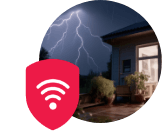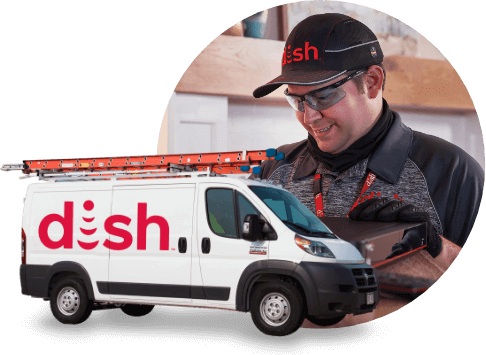Need Internet While Camping? Here are 4 Fool-Proof Ways

Table of Contents
Camping purists might roll their eyes, but it is 2025, and sometimes you want internet in the middle of nowhere. Perhaps you’d like to look up the recipe for the foil packet dinners you found on Pinterest. Maybe you finished your book and need the internet to download your next thriller on your Kindle. Or you might be one of those lucky remote workers who figured out how to turn “working from home” into “working from a hammock beside a waterfall.”
Wanting Wi-Fi while camping doesn’t make you any less of an outdoors enthusiast. You may have Wi-Fi, but you’re still sleeping with the bugs and wildlife! Maybe you’re using a stargazing app to identify constellations, or relying on GPS navigation to find that hidden cavern everyone’s been raving about.
And let’s get practical for a second. What happens when the weather takes a nasty turn and you need real-time radar updates? Having internet access can be the difference between a minor inconvenience and a camping disaster.
Getting reliable internet while camping has never been easier or more affordable. Gone are the days when staying connected required a satellite dish the size of a NASA spacecraft. Today’s solutions range from pocket-sized hotspots to cutting-edge satellite systems.
[search_block]
Options for Accessing the Internet While Camping
The main options you have to access the internet while camping fall into four groups:
- Using your smartphone as a hotspot
- Dedicated mobile hotspot devices
- Portable satellite internet
- Wi-Fi extenders that boost existing signals
Your smartphone probably already has hotspot capabilities built in. This turns your phone into a mini Wi-Fi router that can share its cellular data connection with your laptop, tablet, or other devices. It’s the simplest option and works great for light internet use during short trips.
Mobile hotspot devices are like dedicated mini routers that connect to cellular towers and create their own Wi-Fi networks. These little powerhouses can support multiple devices simultaneously and often offer better range and battery life than using your phone as a hotspot.
Satellite internet brings connectivity to the most remote locations imaginable. If you’re camping where cell towers don’t reach, satellite systems can still beam internet down from space directly to your campsite.
Wi-Fi extenders work their magic by grabbing weak signals from campground Wi-Fi or distant hotspots and boosting them to usable strength. Think of them as digital megaphones that make whisper-quiet signals loud enough to actually use.

Internet in your pocket
Using Your Smartphone as a Mobile Hotspot
Most modern phones can share their cellular data connection with other devices through a feature called mobile hotspot or tethering. It’s like having a Wi-Fi router that fits in your pocket.
Setting up phone hotspot functionality is usually straightforward. On iPhones, go to Settings > Personal Hotspot and toggle it on. Android users can find the option under Settings > Connections > Mobile Hotspot and Tethering. You can customize the network name and password to something memorable.
The biggest consideration when using your phone as a hotspot is data usage. Streaming video, downloading large files, and video calls can quickly burn through your monthly allowance. Most carriers offer unlimited plans, but read the fine print—many slow down speeds after you use a certain amount of hotspot data.
Battery life dwindles faster when your phone pulls double duty as your internet source. Hotspot mode drains batteries faster than normal use, so invest in a good portable charger or power bank. Solar chargers are great for extended camping trips where you can’t easily recharge devices.
Some carriers limit how many devices can connect to your phone’s hotspot, typically 5-10 devices. This works fine for solo campers or couples, but might strain during group camping trips. The range is also shorter than dedicated hotspot devices—usually about 30 feet from your phone.
T-Mobile AWAY
T-Mobile shook up the camping internet world with their AWAY service, which brings home internet speeds to your campsite. This service uses the same 5G gateway device as T-Mobile’s home internet, but removes the location restrictions, letting you take high-speed internet anywhere T-Mobile’s network reaches.
The AWAY service offers two plan options: unlimited data for $160 per month or 200GB for $110 per month. Both plans can be paused during the off-season for just $10 monthly, making them economical for seasonal campers. The gateway device is included with no upfront equipment costs, unlike satellite systems that require expensive hardware purchases.
With just 15 minutes of setup, you have a Wi-Fi network capable of supporting 4K streaming, video calls, and other bandwidth-intensive activities.
The catch is the overage area. T-Mobile AWAY only works where T-Mobile has strong cellular coverage, which might exclude very remote camping locations. However, T-Mobile has been aggressively expanding its rural network coverage, and its 5G network now covers more highway miles than any other carrier.
For RV travelers who stick to established campgrounds and travel routes, T-Mobile AWAY often provides the best balance of speed, reliability, and cost. The ability to pause service during inactive months makes it especially attractive for seasonal campers who don’t need year-round connectivity [1].
Mobile Hotspots
Mobile hotspots are a popular choice for campers due to their convenience. These compact devices are basically portable cell towers that create a Wi-Fi bubble around your campsite. The beauty lies in their simplicity—turn them on, connect your devices, and you’re online.
Most major carriers offer hotspot devices ranging from basic models under $100 to premium units with advanced features. The key factors to consider are battery life, how many devices you can connect simultaneously, and data speed capabilities. Premium hotspots can support 15-20 connected devices, perfect for group camping trips where everyone needs to stay connected.
Data plans for hotspots vary wildly. Some carriers offer unlimited plans (with speed throttling after a certain amount), while others sell fixed amounts of high-speed data. For weekend campers, a plan with 20-30GB might suffice. Full-time RVers or remote workers should look for unlimited options, keeping in mind that “unlimited” often means slower speeds after hitting a threshold
The major carriers each have their strengths in different regions. Verizon typically offers the best coverage in rural areas, while T-Mobile excels in suburban and urban zones. AT&T provides solid middle-ground coverage.

Satellite Internet
Satellite internet has revolutionized camping connectivity, particularly with the arrival of low-earth orbit (LEO) satellite constellations. These systems work by beaming internet signals from satellites orbiting much closer to Earth than traditional satellites, resulting in faster speeds and lower delays.
Starlink leads the satellite camping revolution with its Roam service. The system includes a portable dish that automatically points toward satellites and can deliver broadband-quality speeds almost anywhere. Setup takes minutes—you simply place the dish with a clear view of the sky, plug it in, and connect via the smartphone app.
The Starlink Standard kit costs $349 and works great for stationary camping. For RVers who want internet while driving, the Flat High-Performance dish costs $2,500 but provides stronger signals and can work while in motion..
Starlink’s data plans range from the Mini Roam plan with 50GB for $50 monthly to unlimited options for $150-250 per month. You can pause service when not camping, paying just $25 to keep your account active. This flexibility makes satellite internet practical even for occasional campers.
Satellite internet providers like HughesNet and Viasat also offer portable solutions, though they typically can’t match Starlink’s speeds or low latency. However, they might provide better value for light internet users who only need email and basic web browsing.
Wi-Fi Extenders and Signal Boosters
Many campgrounds offer Wi-Fi, but if it is too weak, Wi-Fi extenders and signal boosters become camping game-changers.
Wi-Fi extenders capture existing wireless signals and rebroadcast them with greater strength and range. The best camping extenders can grab signals from over a mile away and boost them to full strength at your campsite.
Cellular signal boosters work differently—they amplify your cellular phone and hotspot signals rather than Wi-Fi signals. This helps when you have a weak cellular signal but need better performance from your hotspot or phone.
Installation varies by extender type. Some models simply plug into your RV’s 12V outlet and work immediately. Others require mounting external antennas on your roof for maximum performance. Most camping extenders are designed for easy setup without permanent modifications to your RV or equipment.
The key to extender success is having some existing signal to boost. These devices can’t create internet where none exists, but they excel at making weak, unusable signals strong enough for streaming and video calls. They’re particularly valuable at campgrounds with poor Wi-Fi coverage or in areas with marginal cellular reception.

Public Wi-Fi is a security risks
Security Considerations for Using the Internet While Camping
Camping often means using unfamiliar and potentially unsecured internet connections, making cybersecurity more important than ever. Understanding the risks and taking appropriate precautions protects your personal information and devices while traveling.
Public Wi-Fi networks—including most campground connections—are security risks. Other users on the same network can potentially intercept your data, and malicious actors sometimes set up fake networks to steal information. Never access sensitive accounts like banking or shopping sites over public Wi-Fi without additional protection.
Virtual Private Networks (VPNs) provide essential protection when using public Wi-Fi. VPNs encrypt all data between your device and the VPN server, preventing anyone else on the network from seeing your activity. Choose reputable VPN services with good mobile apps and sufficient data allowances for your camping needs.
Your own hotspot devices create more secure connections than public Wi-Fi, but they’re not bulletproof. Use strong passwords for your hotspot networks—avoid simple passwords like “camping123” that others might guess. Change the default passwords that come with new devices.
Be cautious about what you do online while camping. Save sensitive transactions for when you return home or use more secure connections.
Cost Analysis
Camping internet costs vary dramatically depending on your chosen solution. Understanding upfront and ongoing costs helps make informed decisions that fit your budget and camping frequency.
Smartphone hotspot plans offer the lowest entry cost, especially if you already have unlimited data. Adding hotspot capability to existing plans typically costs $10-20 monthly. However, data limitations and battery life constraints might require upgrades that increase costs.
Dedicated hotspot devices require upfront equipment costs ($50-300) plus monthly service fees ($20-80). The initial investment pays off for frequent campers who need dedicated internet devices. Look for carrier promotions that include free or discounted devices with service commitments.
Satellite internet has the highest upfront costs but provides top-tier coverage. Starlink equipment costs $349-2,500, depending on the system, plus monthly service fees of $50-250. Despite high initial costs, satellite provides the best value for remote camping where other options don’t work. For digital nomads who need stable internet for work, a satellite provider like Starlink is your best option.
Wi-Fi extenders and signal boosters require one-time equipment purchases ($100-500) but no ongoing service fees beyond your existing internet plans. They provide excellent value for RV campers who frequent campgrounds with Wi-Fi or areas with marginal cellular coverage.
Calculate your annual camping internet costs by considering both fixed and variable expenses. Fixed costs include equipment purchases and base service fees. Variable costs include data overages, roaming charges, and seasonal service activation fees.

Research your carrier coverage
Accessing the Internet While Camping Internationally
Camping adventures increasingly cross international borders, creating a whole new slew of connectivity challenges. US carrier roaming in Canada and Mexico varies significantly between providers. T-Mobile includes Canada and Mexico data in many plans, while Verizon and AT&T charge extra for international usage. Research your carrier’s international policies before crossing borders to avoid surprise charges.
Some camping internet solutions work across borders better than others. Starlink offers coverage in most of North America with a single plan, making it excellent for cross-border RV travel.
Local SIM cards often provide the best value for extended international camping. Purchasing local cellular service in Canada or Mexico typically costs much less than US carrier roaming charges. Unlocked hotspot devices make it easy to switch between different carriers’ SIM cards.
Plan international camping connectivity carefully. Download offline maps and content before crossing borders. Research cellular coverage in your destination areas. Consider carrying multiple devices with different carriers for backup options.
Find Internet Providers and Solutions for Your Next Camping Trip
Maybe you need blazing-fast speeds for uploading drone footage, or maybe you just want enough juice to video call grandma. Both are entirely valid and entirely doable.
If you’re thinking, “I’m ready to find internet providers near me,” then we are here to help.
Enter your zip code here to discover the best internet providers and plans in your area. Find the perfect solution for your camping style and start planning that trip you’ve been dreaming about—because life’s too short for bad Wi-Fi and missed adventures!
Frequently Asked Questions
What’s the average cost of internet per month?
The average cost ranges from $30-80 per month, depending on speed and provider. Promotional rates are often lower for the first year.
Why is my internet so expensive?
Internet costs reflect infrastructure investment, maintenance, equipment, customer service, and profit margins. Areas with limited competition often have higher prices. Make sure to review your internet bill for hidden fees to avoid unexpected or unnecessary charges.
Sources
[2] Satelliteinternet.com. “Camping Wi-Fi"












 Call
Call 

 Access Your Account
Access Your Account